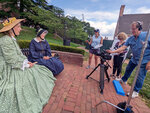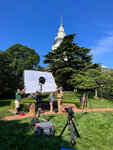 Severna Park
Severna ParkPartly Cloudy, 57°
Wind: 6.9 mph, S
 Severna Park
Severna Park



The Round Bay community contains a piece of little-known history: a hilltop that was vital to the defense of Washington, D.C. during the Civil War.
Magothy River Association (MRA) President Paul Spadaro and Round Bay resident Danielle Dupcak researched that history for three years, unearthing documents, letters and newspaper articles. With the Berrywood resident Charles Germain as director, MRA released a 12-minute film, “Fort Grey, Mount Misery: A Local Civil War Story” in August.
The film is the latest in the MRA’s Living History series, which includes videos on Beachwood Park, the Old Stone House and Goshen Farm.
During a screening at Boone Station Hall in July, MRA welcomed historians and community members to celebrate the newest filmmaking accomplishment.
“By preserving the history of Fort Grey, we will preserve the land and preserve the Magothy and the Severn rivers,” Spadaro said.
The film combines interview footage, a New York Times letter penned by a soldier, and re-enactments based on letters found in the Maryland Archives. Together, those elements tell the story of Fort Grey.
As U.S. Naval Academy professor Mary DeCredico explained in the film, Annapolis, Maryland’s southern counties and the Eastern Shore were pro-secession. The western counties, which did not “have as deep a stake in slavery,” were pro-Union.
“So here you have a conflicted governor, Thomas Hicks, who is trying to keep the state together,” DeCredico said. “He is pro-Union, but he realizes how strong secession sentiment is in the state, so he’s really walking a very difficult line.”
On April 15, 1861 — three days after an attack on Fort Sumter in South Carolina and two days before Virginia seceded — President Abraham Lincoln called upon Union states to send 75,000 militia to defend Washington, D.C.
“It was in this dangerous situation that Lincoln ordered General Benjamin Butler, a Massachusetts Unionist Democrat who despised secessionists, a political general who had his heart in the work he was doing, to occupy Annapolis and seize all the fortified areas and seize all the prominent high ground from which guns could command the transportation corridor between Annapolis and Washington,” said Rick Striner, a Lincoln scholar, author and retired professor at Washington College.
Fort Grey was situated on one of those areas of high ground, overlooking the nation’s capital. Mount Misery, as the hilltop was known by the Eighth New York Regiment stationed there, was a perfect position for the troops to protect the passage to Washington via Annapolis, either by land or by sea.
Butler ordered a detachment of the Eighth New York Infantry Regiment to erect a fort on the eminence known as Mount Misery.
For the rest of the story, viewers are encouraged to watch the film.
As for the team’s filmmaking choices, Germain said he wanted to create a short and fast-paced video. He used wide-angle shots to feature the State House in the background of certain shots. Sound effects of people marching and roosters crowing, and a regiment song, added another element of reality.
“We used sepia and old paper [as a background for the text], so you feel like people are talking from the grave,” Germain said.
A residential development is currently pending, and if approved, would be constructed on part of the hillside where Mount Misery was located. With that in mind, Spadaro and Germain emphasized the importance of sharing the site’s history.
Germain also wants to secure funding for bigger productions in the future. This video was supported in part by the Arts Council of Anne Arundel County and the Anne Arundel County Office of Planning and Zoning’s Cultural Resources Division.
“I try to find stories that have never been told,” Germain said. “If you don’t preserve your history, you have no future.”
Striner said the Civil War outpost in Severna Park was vital to securing Annapolis and the northern route to Washington for the Union.
“From the top of this promontory, viewers could look down upon Annapolis, viewers could look down upon the Severn River, viewers could look down upon the roads leading between Annapolis and Washington,” Striner said in the film. “They could train their guns on the area. It was absolutely vital for the defense of Washington, for the defense of the president and his cabinet, for this hill to be taken and held, and that is what troops under Benjamin Butler accomplished in the second half of April 1861.”
Comments
No comments on this item Please log in to comment by clicking here